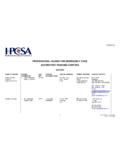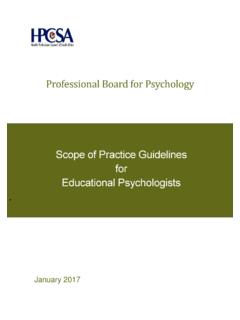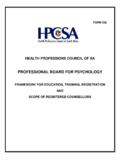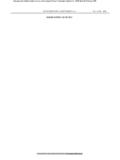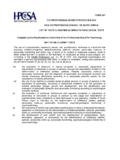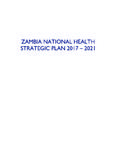Transcription of HEALTH PROFESSIONS COUNCIL OF SOUTH AFRICA
1 FORM 288. HEALTH PROFESSIONS COUNCIL OF SOUTH AFRICA . professional board FOR emergency care PRACTITIONERS. BASIC LIFE SUPPORT PROVIDER GUIDELINES. JANUARY 2006. IMPORTANT NOTICE TO ALL REGISTERED BASIC LIFE SUPPORT PROVIDER. Herewith the January 2006 booklet containing the most recently approved Medications, Guidelines, Capabilities, Regulations and Ethical Rules for Registered Basic Life Support Providers (Basic Ambulance Assistants and emergency care Assistants) as approved by the professional board for emergency care Practitioners (PBECP). It is imperative that you familiarise yourself with the entire content thereof, as this document and the inherent recommendations and guidelines replace all previous versions and publications issued under the authority of the professional board for emergency care Practitioners. Any comment or enquiries in this regard can be directed in writing to Ms Alta Pieters, the board Manager of the professional board for emergency care Practitioners, at the address below: The Registrar HPCSA.
2 P O Box 205. Pretoria 0001. Fax no (012) 328 4862. e-mail: Website: 1. PLEASE TAKE CAREFUL NOTE- These documents are intended to serve as guidelines for the treatment of patients by registered Basic Life Support Providers and do not replace sound clinical judgement. Consultation with ILS Providers, ALS Practitioners, or medical practitioners in challenging or difficult situations is strongly advocated. It is your medico-legal responsibility to ensure that all the necessary and appropriate documentation is duly completed and processed. The onus rests upon the Basic Life Support Provider to ensure that he/ she is adhering to the correct and most recently HPCSA approved standards and guidelines. For acknowledgements and references, please refer to ALS protocol document on HPCSA website. 2. ANNEXURE 3. professional board FOR emergency care PRACTITIONERS. RULES OF CONDUCT SPECIFICALLY PERTAINING TO THE PROFESSION OF. emergency care . In addition to the rules of conduct referred to in rules 2 to 27 a basic life support provider, an intermediate life support provider and an advanced life support paramedic or a basic life support student, an intermediate life support student and a student advanced life support paramedic shall also adhere to the following rules of conduct.
3 Failure to comply with these additional rules of conduct shall constitute an act or omission in respect of which the board may take disciplinary steps in terms of Chapter IV of the Act: 1. Performance of professional acts by a basic life support provider, an intermediate life support provider or an advanced life support paramedic Notwithstanding the provisions of rule 21, a basic life support provider, an intermediate life support provider or an advanced life support paramedic . (a) shall not perform any professional act or exercise any capability per incident, other than those set out in the relevant protocol or annexure to such protocol as approved by the board ;. (b) shall not hand over the responsibility for the treatment of a patient to any person who is less qualified or experienced than himself or herself, unless such a basic life support provider, intermediate life support provider or advanced life support paramedic assumes full responsibility for the acts performed by such other person.
4 2. Performance of professional acts by a student basic ambulance assistant, a student emergency care assistant, a student ambulance emergency assistant or a student paramedic A student basic life support provider shall only perform professional acts under the supervision of a registered intermediate life support provider and, in the case of an intermediate life support student and/or student advanced life support paramedic, under the supervision of a medical practitioner or an advanced life support paramedic and to limit such acts to acts directly related to his / her education and training. 3. TABLE OF CONTENTS. MEDICATIONS BLS PROVIDER PROTOCOLS. NO. MEDICATION. 1 Activated Charcoal 2 Oral Glucose Powder/ Gel 3 Medical Oxygen 4 Nitrous Oxide : Oxygen ALGORITHMS. Basic Life Support Algorithm Choking Algorithm 4. ACTIVATED CHARCOAL. DESCRIPTION. Classification: Carbon Schedule: 1. PHARMACOLOGICAL ACTION. Activated charcoal adsorbs many poisonous compounds to its surface, thereby reducing their absorption by the GIT.
5 ADVERSE EFFECTS. The patient may experience mild constipation INDICATIONS. To assist in the treatment of certain cases of overdoses and poisonings where the agent/s was/were orally ingested within first hour of ingestion CONTRA-INDICATIONS. SHOULD NOT BE USED IN POISONING WITH iron, organophosphates, ethanol, lithium, boric acid, cyanide, ethylene glycol, methanol, petroleum products, strong acids and alkalis Unprotected airway in a patient with decreased level of consciousness Do not use if the container was not properly sealed (de-activation due to moisture exposure). PACKAGING. Fine black powder in bottles of 25g and 50g DOSAGE AND ADMINISTRATION. Adult and Paediatric: - 1g/kg mixed with water, given orally 5. ORAL GLUCOSE POWDER/ GEL. DESCRIPTION. Classification: Carbohydrate Schedule: 1. PHARMACOLOGICAL ACTION. Administration of an oral glucose solution / preparation provides a source of soluble carbohydrates to the tissues in order to raise the blood glucose levels ADVERSE EFFECTS.
6 Hyperglycaemia INDICATIONS. Acute management of hypoglycaemia HGT < 3,5mmol/l CONTRA-INDICATIONS. No absolute contra-indications PRECAUTIONS. Patient must be lateral if unconscious Avoid aspiration PACKAGING. 25g and 50g powder sachet 25g and 50g gel DOSAGE AND ADMINISTRATION. 25g of gel applied to the oral mucosa of the patient with a gloved finger Preferably dilute powder in glass of water if patient is conscious Repeat after 5 minutes should blood glucose remain < 6. MEDICAL OXYGEN. DESCRIPTION. Classification: Naturally occurring atmospheric gas PHARMACOLOGICAL ACTION. Oxygen is an odourless, tasteless, colourless gas present in the atmosphere at a concentration of approximately 21% of local atmospheric pressure It reverses the deleterious effects of hypoxaemia on the brain, heart and other vital organs Expired air contains 16-17% oxygen During optimal active CPR only 25-30% of the normal cardiac output is maintained and for these reasons supplemental oxygen should be administered INDICATIONS.
7 Glasgow Coma Scale < 15/15. S PO2 < 90%. Any patient with abnormal vital signs Any respiratory insufficiency or arrest Acute decompensation of COPD / Asthma Confirmed or suspected hypoxia Severe anaemia Chest pain of medical or trauma origin Multiple or severe trauma Cardiac arrest / cardiac failure Toxic inhalations Prophylactically during air transportation Scuba diving accidents CONTRA-INDICATIONS. There are no absolute contra-indications for the use of oxygen in the emergency setting PRECAUTIONS. High concentrations of oxygen may reduce the respiratory drive of a COPD patient;. therefore, careful monitoring of the patient is required. Do not withhold oxygen from these patients if their prevailing condition is such that oxygen is required. Long exposures to high concentrations of oxygen may result in retrolental fibroplasia in neonates and pulmonary fibrosis Neonates with a patent ductus arteriosus (PDA); should cyanosis and signs of hypoxia develop after oxygen administration, remove oxygen.
8 In some infants with a PDA and congenital heart disease, the presence of the PDA may be lifesaving because of ductal- dependent systemic or pulmonary blood flow. Increased oxygen concentration tends to constrict the foetal ductus arteriosus. 7. Oxygen supports combustion - do not use in the presence of fire, smoke or cigarette smoking High pressure oxygen should not be used with oil or grease based substances as it causes an exothermic reaction with the risk of explosion Production of superoxide radicals in the presence of paraquat (herbicide) paraquat and oxygen enhance each other's toxicity, causing severe pulmonary injury. Remove oxygen source to one metre away from defibrillation pads / paddles. PACKAGING. Pressurised cylinder containing 100% medical oxygen DOSAGE AND ADMINISTRATION. Administered via: - Oxygen masks - Nasal cannulae - Bag-valve-mask / tube-reservoir device - Nebulizer device - Jet insufflation At the correct flow rate the following devices will deliver the following approx.
9 FiO2: - Simple face mask = 35 - 60% at 6 - 10 L/minute - Venturi mask = 24 50% at 4 12 L/minute (manufacturer's instructions). - Nasal cannulae = 21 - 40% at 1 6 L/minute - Partial re-breather mask = 35 - 70% at 6 10 L/minute - Non-re-breather mask = 60 100% at 6 15 L/minute - Bag-valve-mask/tube = 50% at 12 - 15 litres/minute - Bag-valve-mask/ tube-reservoir device = 95 100% at 15 L/minute (Adequate flow rate = Reservoir bag inflated > 1/3 of its volume at all times). 8. NITROUS OXIDE and OXYGEN (ENTONOX ). DESCRIPTION. Classification: Analgesic gas Schedule: 4. PHARMACOLOGICAL ACTION. Colourless, sweet-smelling, non-irritant gas Heavier than room air / oxygen Nitrous oxide has mild analgesic and anaesthetic effects depending on the dose inhaled When inhaled it depresses the central nervous system causing anaesthesia In addition, the high concentration of oxygen delivered along with the nitrous oxide increases oxygen tension in the blood, thereby reducing hypoxia It provides rapid, easily reversible relief of mild to moderate pain PHARMACO-KINETICS.
10 Extremely blood-insoluble Not metabolised by the body Eliminated via lungs (small amounts are eliminated through the skin). Onset of action: 30-60 seconds (maximum 3-4 minutes). ADVERSE EFFECTS. Light-headedness Drowsiness Nausea and vomiting INDICATIONS. Relief of pain from: - Acute myocardial infarction - Musculoskeletal trauma - Burns - not including burns of the respiratory tract - Active labour - Any other condition requiring pain relief provided there are no contra-indications present CONTRA-INDICATIONS. Neurological impairment: - Any altered level of consciousness - Inability to comply with instructions - Head injuries Air entrapment: - COPD/asthma patient during an acute episode 9. - Acute pulmonary oedema - Chest injuries - Abdominal trauma - Diving accidents (specifically Acute Decompression Illness). - Burns to the respiratory tract Other limitations: - Hypotension (SBP < 90 mmHg). - Major facial trauma (anatomic). PRECAUTIONS. The constituent gases nitrous oxide and oxygen disassociate at < 4 C.
